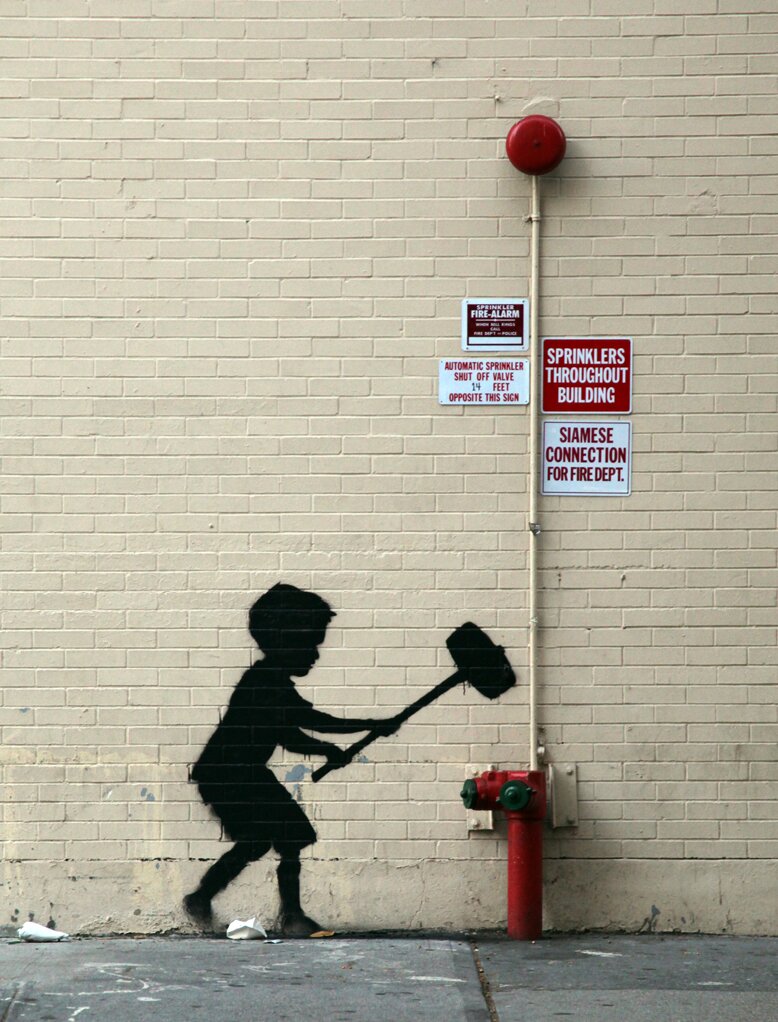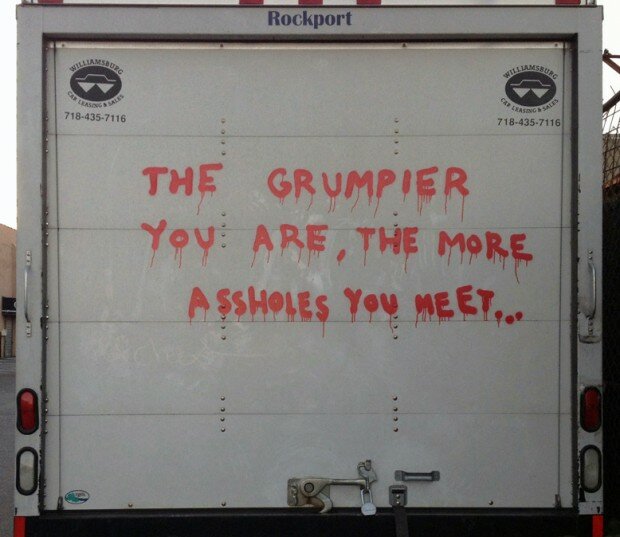It’s simple. A black silhouette of a child quickly sprayed onto a brick exterior of one of the thousands of buildings that engulf Manhattan. There are many others almost exactly like it on many other brick exteriors of many other buildings. The difference? Those many others aren’t worth hundreds of thousands of dollars.
This one was born from the hand of highly illusive British graffiti artist and renowned social activist Bansky and lets just say it’s worth a little more than the aerosol can from which it originated. The pseudonymous artist, widely known for his darkly satirical work in film, literature and art hopped across the pond at the beginning of October to begin what is now his wildly acclaimed residency in New York City. Each night since the first of the month, Bansky has inconspicuously slid through the city’s boroughs and by dawn, has installed a new, thought provoking piece on a haphazard corner, junkyard, or dumpster.

Via: banksyny.com
A vague location and image of the work is then posted to his personal site Better Out Than In (http://www.banksyny.com/), validating its authenticity amongst those of imposters. Spectators, art critics, and tourists next play an intense game of treasure hunt, stalking a series of media-derived clues until arriving at the latest masterpiece where they can then tweet, upload and gab to their hearts’ content.
The level of press-attention dedicated toward the artist’s current exhibition is simply unmatched. Try searching #banksy on Instagram and you’ll quickly be bombarded by images and captions crooning over his public hype. But why? Why has Banksy’s latest endeavor gained such monumental attention? When we drive by a neon four-letter word eclipsing a concrete pipe on I-75, we don’t flinch. But when a keeper of artistic value does it, it’s suddenly transformed into solid gold and swarmed by a hive of media networks in the blink of an eye. The appeal lies in both his celebrity and his anonymity.
To say that the undercover art icon leads a camouflaged life is an understatement. Since the start of his career in the early 1990s, Banksy has managed to physically slip under the radar while simultaneously exploding onto the street art scene; a feat which immediately differentiated him from other fame-hungry VIPs of the current, digital media era. He has devised some of the most controversial and publicly exploited concepts within the past twenty years, but has consistently offered little available insight regarding his political motives and personal opinions.
In 2006, for example, Banksy infamously defaced, redesigned and redistributed 500 copies of Paris Hilton’s debut album Paris into 48 various UK music stores. The Banksy copies included his own cover illustration of a topless or Chihuahua-headed Hilton, remixed tracks by Danger Mouse, and ironically dubbed song names such as “Why Am I Famous?” and “What Have I Done?” Several of these CDs were then purchased by consumers and prior to government reclamation, were selling on auction sites for around £ 750.
Clearly the artist has something to say about artistic success, social order, and modern culture. What is interesting is his avoidance in saying it. Even in his recently voluntary interview with New York’s Village Voice, Banksy gives little away about himself and his motives. When asked about his vision and concept behind Better Out Than In, he simply states: “There is absolutely no reason for doing this show at all. I know street art can feel increasingly like the marketing wing of an art career, so I wanted to make some art without the price tag attached. There’s no gallery show or book or film. It’s pointless. Which hopefully means something.”
And mean something, it does. At least in my eyes. As a self-proclaimed art enthusiast and novice painter, I am both intrigued by Banksy’s physical work and by his unyielding reluctance to succumb to the scrutiny of the public eye. Impressionist artist Edgar Degas once proclaimed: “Art is not what you see, but what you make others see”. It’s undeniably true that Miley Cyrus made us see her latex-clad camel toe at the VMAs. Lady Gaga certainly made us scratch our heads after nonchalantly accepting an award while clad in an uncooked, flank steak ball gown. But do these excessive, “look at me!” spectacles have any creative worth? In an age where public exposure relies upon over-exposure, tweets per minute, and circus freak personas, can an honest form of art even exist? The current “all publicity is good publicity” mentality of the staged character personalities of modern megastars is consequently discrediting their artistic value. And while we might relish in tabloid gossip about Cyrus’s inability to keep her tongue in her mouth or whether Kanye West woke up on the wrong or right side of his bi-polar bed, would today’s artists even be considered untouchable without the motives of their press teams and spreads in Us Weekly? I would like to think that integrity is still the driving factor behind art, but in a world of ankle-monitored starlets, private jets, and brand labels, I think it has definitely taken a back seat on the crazy train of fame.
We might never see Banksy’s face. This perpetual, “Where’s Waldo” search for the artist may never cease and he may forever keep us guessing. In all likelihood we will probably never understand what drives him, makes him tick, or what causes him to fill a storage truck with hundreds of stuffed animals and call it art. And I’m okay with that. The media continues to prod and dissect his objectives, but what they fail to realize is that they are perfectly clear. Banksy doesn’t want to be found. He would rather create work that makes his audience feel something than allow any chance of egotism or personal reflection tarnish it. While he may forever remain a man without a face, his passion will continue to make us stop, think, stare, and reflect. We will probably never know the inspirational entirety of the shadowed boy with the mallet stenciled in black on the Upper West Side, but that, in itself, is entirely the point.
Photo couresty of: postersandprintsblog.com






